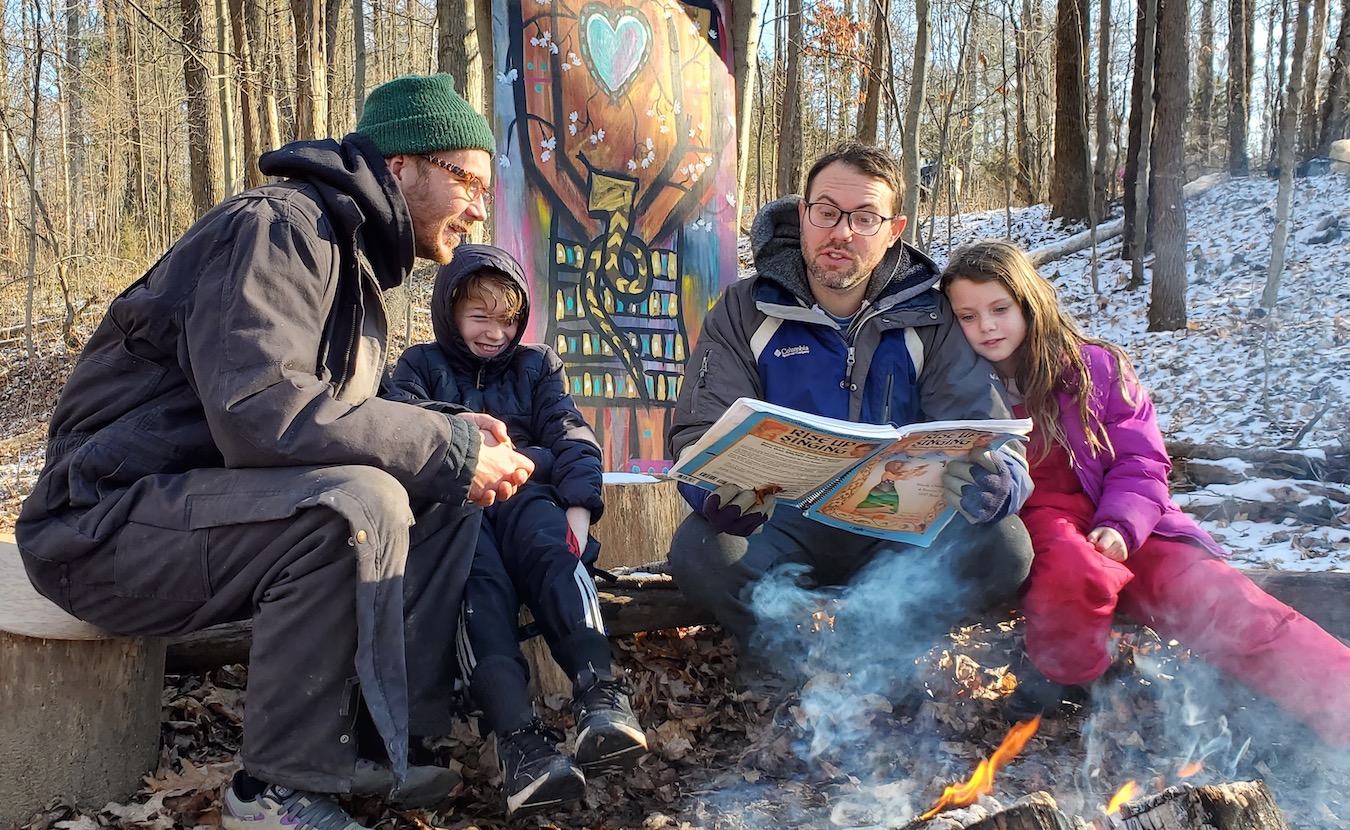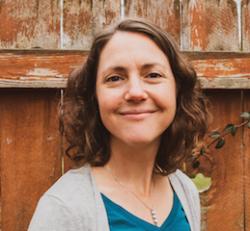When the first shelter-in-place order was issued in March 2020, my family and I were nine months into living at Common Home Farm, an intentional farming community we helped start on ten acres of land north of Bloomington, land that was formerly the hunting grounds of the Miami and Shawnee people. Just prior to the order, we were caught in a familiar cycle of busyness. Our time and energy were scattered around the county, driving kids to activities and going to work. We were short on the kind of at-home time it takes to be and build a community. Then suddenly we were told to cancel our plans and stay home.
Spring on the farm became the foreground as the rest of my busy life dropped away. I entered the kind of slow time that blossoms and leaves always inhabit. I encountered a reverence for the quiet life of the forest where I went when I was overwhelmed by fear, uncertainty, and heartache for the sick. Parker J. Palmer, a community practitioner and writer, observes that “We cultivate a capacity for connectedness through contemplation…. By contemplation I mean any way one has of penetrating the illusion of separateness and touching the reality of interdependence.”
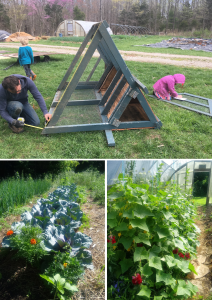
(top) David, Leo, and Alice Lasuertmer turn an old chicken coop into a rabbit hutch at Common Home Farms. (bottom) The garden and greenhouse. | Photos by Laura Lasuertmer
The pandemic was a contemplative exercise — a confusing and often painful one — that revealed to our nation the ever-present truth of our interconnectedness. People living in intentional community have built common lives on this truth: They daily engage in the contemplative art of cooperative living as they share the work of washing dishes, raising children, and tending to the health of their interpersonal relationships.
Intentional communities are a global and historical phenomenon. They are monasteries, ashrams, kibbutzes, eco-villages, and cooperative housing groups, among others. In intentional community, people create a life together based upon a common vision and values. This often involves sharing resources (e.g., land, housing, income) and responsibilities (farming, hospitality, education, raising children). Southern Indiana is home to a number of intentional communities, some well known and extinct (New Harmony), others well established and stable (St. Meinrad, The Sisters of Ferdinand, May Creek Farm), and others just beginning the journey of communal life (Bloomington Co-Housing and my own Common Home Farm).
The pandemic has been a time of pronounced interconnectedness but also, paradoxically, a time of social isolation. How have local intentional communities weathered the pandemic? How did a foundation of interconnectedness change the experience of life during school closures and stay-at-home orders? How did community life have to change and adapt? In the fall of 2021, as the worst of the pandemic seemed over, I took my questions to members of four local intentional communities: The Bloomington Catholic Worker, Bloomington Co-Housing, Green Acres Permaculture Village, and Bloomington Cooperative Living. Together we reflected on the struggles and the gifts of living in intentional community while the pandemic was unfolding in 2020.
These conversations highlighted that in uncertain times, we rely heavily on the networks of support that we have already established. As COVID shifts from being a pandemic to an endemic, we have the opportunity again, and with less pressure and urgency, to build up networks of mutual support both within our intentional communities and in the wider community. These connections of mutuality can create the resilience that we need to weather the next pandemic or economic, environmental, or political crisis.
The Bloomington Catholic Worker
“How do we mix this killing germ and hospitality?” –Andrea Martinie Eiler
The Bloomington Catholic Worker (BCW) is an intentional community comprising two families and one single adult who provide housing to people experiencing homelessness. The community members and the guests live in four houses on Blair Avenue on the city’s northwest side. The BCW is part of the larger, decentralized Catholic Worker movement founded in 1933 by pacifist activists Dorothy Day and Peter Maurin. I was a member of this community from 2009 to 2018. It’s where I lived as a newlywed, where my children were born, and where I was educated in the contemplative art of cooperative living. Though our family moved to start Common Home Farm, we are still connected with the folks on Blair Avenue. It was a bright spot in my week to stop by “the Community,” as my daughter still calls it, to speak with my friend and one of the founding members, Andrea Martinie Eiler.

Andrea Martinie Eiler of The Bloomington Catholic Worker says it was worth the health risk “having other people around to share life with.” | Limestone Post
When the pandemic began in March 2020, one of the main questions for the BCW was how they could continue to offer hospitality to people experiencing homelessness. “We are called to house people who are homeless,” Andrea says, “but how do we mix this killing germ and hospitality? So we decided to pack our houses [with guests].” The community filled the six guest beds — two beds in each of the three houses — and began to shelter in place as a pod of sixteen people. Within a month, however, several of the guests decided to move out, leaving each family with one guest. Matt, as a single adult community member, was able to live with two guests. “That was a movement of the spirit,” Andrea says, “because we were so stressed having so many people in the houses.”
Despite the difficulty of the situation, Andrea says, “it was worth the health risk to say one of my priorities is having other people around to share life with, even during this weird kind of scary time…. We’re really thankful that our guests had safe, healthy community to interact with as well.” She told me about a guest, Bill, who couldn’t get around very well and was often having surgeries. Had he been on his own during the pandemic, without the library or the Shalom Center to visit, he would have been isolated in his own apartment, or worse, living outside and at the shelter. But at the BCW, he had housemates to eat with, someone to go to the grocery store for him, and a new flock of chickens to watch as he smoked on the back porch.
Another difficulty was responding to the changing information about the virus. “My main thing from the pandemic will be the agonizing continual decisions,” Andrea says. “All these little decisions that just piled and piled felt really weighty, and they were always affecting multiple people.” The Bloomington Catholic Worker uses a consensus-based decision-making process, which means that everyone’s voice has equal weight and that decisions must be unanimous. The process is often slow and particularly challenging in crisis situations. Different people in the community had different levels of risk, so the community agreed on protocols that would protect the most vulnerable people: They drove guests to the store rather than have them ride the bus; they wore masks with anyone not in their pod. Andrea notes the difficulty in choosing what was healthiest: “There are a lot of categories [in health] and you have to pick. Healthy for us was risking somebody else’s germs because staying healthy also meant human interaction face to face regularly.”
Bloomington Cohousing
“It’s such tiny practical things that make the community.” –Kate Burch
On a mild October evening, I joined Alex and Kate Burch on the screened-in porch of their new salmon-colored home. The house was quiet: Their one-year-old daughter, Caroline, was already asleep. They offered me a cookie as I asked about what brought them to live in the cohousing neighborhood. They took turns telling the story of the last couple years, Alex with a bit of speed and eagerness and Kate with steady confidence.
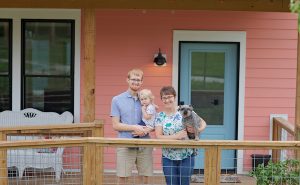
Alex and Kate Burch, with their daughter, Caroline, at their Bloomington Cohousing home, experienced pandemic life in both a traditional neighborhood and a cohousing community. | Photo by Laura Turner Photography
Alex and Kate were living in the Bryan Park neighborhood when the pandemic began. The topsy-turvy nature of the pandemic meant that their lives were changing drastically. In 2019, they had discussed buying a home in the new cohousing community being constructed by Loren Wood Builders on Bloomington’s southeast side. In a cohousing community, the homes are owned privately but the land is communal. Bloomington Cohousing also has a community kitchen and gathering space, covered parking, and a communal garden, as well as a cabin that residents can use to host visitors. They were attracted to cohousing because Alex, an extrovert, wanted to live around a lot of people while Kate, an introvert, wanted to be able to retreat to the private space of their home when needed. But in 2019 they were still adjusting to life with Caroline, so they agreed to revisit the conversation in 2020.
When 2020 came around, it was a very different kind of year. Kate says, “I kind of blame the pandemic because we were sitting at home for months and months and months, saying, ‘I don’t really like this house. What are we doing?’ It really got us to focus.” She noticed how making a life-changing decision in the context of the pandemic didn’t feel crazy: “Moving into cohousing just felt like a big experiment…. It was another thing that was different from our normal life, [but] everything was different already.”
Alex and Kate experienced pandemic life in both a traditional neighborhood and a cohousing neighborhood. They were friendly with their former neighbors, but they found it difficult to develop deeper friendships. They felt uncertain about how connected the neighbors really wanted to be. Kate says that neighborhood relationships feel different in cohousing: “Everyone who moves [to cohousing], moves here because they want to live in an intentional community. You are friends with them already. It’s a very strange and really kind of delightful relationship.”
In the cohousing community, it was easy for residents to gather and get to know one another while working together on the shared garden or playing outside with the children. Kate noticed that the community really started to come together the first time that someone asked for help. “It’s such tiny practical things that make the community. Some of our neighbors who are retired call Alex if they need something carried from the car. So you feel like every time something like that happens, it’s one more step toward community.”
Green Acres Permaculture Village
“We’re experimenting with new ways of doing things. We’re building parallel structures and decentralized networks all inside the decaying culture around us.” –Anne Kreilkamp
Anne Kreilkamp started the work of creating community in 2009 when her husband passed away and left her his inheritance. She was in her sixties, living in a small house in the Green Acres neighborhood on the east side of Bloomington. “I didn’t identify with the money,” Anne says. “I just knew that it was supposed to be used in a way that was regenerative, that could show something to the world.”

Anne Kreilkamp founded Green Acres Permaculture Village in 2009 on the east side of Bloomington. It is now an intentional community of three houses, eight adult members, animals, and gardens. | Limestone Post
Knowing Anne’s interest in new ways of thinking, a neighbor encouraged her to take a course on permaculture, an approach to land management and food production that mimics natural processes. She took his advice and soon afterward began to transform her lawn into a community garden. As the garden grew, she began having events and dinners in the garden space. She realized that the garden was creating the community: “We started to recognize that the garden is what we are doing, is part of us. The actual motto is: ‘Growing community from the ground up.’ Once the community garden took off, Anne started to dream big. “I thought I could regenerate this entire neighborhood — that’s 460 houses, most of which are rentals.” She quickly realized that rather than disperse and exhaust all her energy trying to transform a transient population, she could turn her small but growing garden into a “magnetic attractor.”
Anne eventually used the money from her inheritance to purchase two other adjacent homes and convert those lawns into gardens as well. She rents rooms to people who are interested in living closely with others: sharing meals, working in the garden, tending the chickens, and creating and maintaining the physical infrastructure of the community. The community now has nine bedrooms across the three homes, with members staying anywhere from several months up to ten years.
During the pandemic, the members of Green Acres had three houses they could move about in freely. They had gardens to work in and plenty of outdoor space for gathering. “We were so grateful to be here. We lived in paradise,” she says.
Still, there were difficulties, as the members of the community did not agree on how best to respond to the threat of the coronavirus. Anne seemed undaunted by the divergent opinions. She advised the group: “Let’s stay with what we have in common, what we’re doing here. So some people are vaxxed, some aren’t. But everyone has a right to whatever they feel, whatever they think.” This illustrates a common challenge in community life: How do you make space for individual differences while maintaining the unity of the group? Anne’s solution, whether in a pandemic or in other moments of disagreement, is to emphasize the points of connection between people and within the community.
Maybe that is why she loves to watch people sit at the bench by the Little Free Library in front of her house and to wander slowly through the growing garden. “We’re experimenting with new ways of doing things,” Anne says. “We’re building parallel structures and decentralized networks all inside the decaying culture around us. So it’s a wonderful movement, and when you can feel that, and you’re connecting with other people who are doing the same thing, it’s very exciting.”
Bloomington Cooperative Living
“We were resilient as a community because we already had these systems in place to support each other.” –Jasper Wirtshafter
On a sunny day in mid-October, I rode my bicycle over to Which House, a giant white house on Atwater Street with a garden of fading zinnias and nasturtiums. I walked up the back porch and past a chalk message that reminded me, “You are full of magic.” Inside the house, sitting at a large kitchen table, were current board members and residents of Bloomington Cooperative Living (BCL): Zackary Dunivin, Jasper Wirtshafter, and Carsten Stoltz.
Bloomington Cooperative Living is a nonprofit housing cooperative of four houses (Goodlawn, Middle Earth, Which House, and The Trellis) that are democratically run by its 60 members. The members of the cooperative pay room and board and cooperatively cook and clean. Each house is organized and run by the people living in the house, and all the members come together to make decisions for the co-op as a whole.
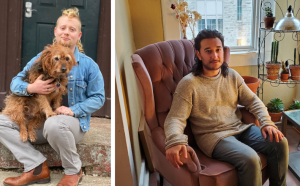
Jasper Wirtshafter (left, with Cecil) and Zackary Dunivin are members of Bloomington Cooperative Living, which includes four houses democratically run by its 60 members. At the start of the pandemic, they realized they needed to create agreements to keep everyone safe. | Photos by Laura Lasuertmer
During normal times, monthly house meetings last only an hour and are not contentious. At the start of the pandemic, however, as COVID emphasized the interdependence of the members, they realized they needed to create agreements about how to act together in order to keep everyone safe. Finding their way to a coherent COVID protocol that all house members could agree upon was challenging work. As Jasper, a resident of Goodlawn, says,
Meetings got harder because there were necessary conflicts to have. Conflict isn’t a bad thing. At minimum, this is just a big house with a lot of people in it who buy food together and it ain’t that deep, and you don’t have to agree on stuff. [In normal times], we each live our own pretty independent lives from each other and that works great. We did not agree to all live in a house together in some sort of 16th-century horror short story where we don’t see anybody and we have to all agree about what’s safe in a world where we have no idea what’s safe. And so meetings became that.
The members of Jasper’s house were determined to write a policy that everyone could enthusiastically agree with. It took months of hard conversations, but in the end they voted on a strict 15-page policy: Residents would only spend time indoors, without masks, with other residents of the house; they would not work in-person out in the community; any hanging out with other friends or family would be outdoors, distanced, and masked. Any residents of Goodlawn who were unable to follow the policy could move into Middle Earth, where residents could continue to work in-person jobs and make visits to see family.
Carsten described Middle Earth’s decision to be more lax on COVID safety policies as a result of three factors: uncertainty in the face of changing science, pandemic fatigue, and wanting policy that accurately reflected people’s behavior in the house:
The first several weeks of the pandemic, I had a more cautious disposition. Then it flipped and some folks were really intense about it for a few months, but then around half of those folks burned out after being intense and locking down. Then it flipped again and I was more interested in masking and locking down and they were bored of it…. Then [cases were] spiking over the summer, so we thought maybe we should be more strict and not less strict. And they were like, “Yeah, but it’s been so long.”
Carsten saw that there was not consensus in the house for a strict COVID policy, and he wasn’t interested in adopting a policy that no one would follow. So Middle Earth became the house with the most lax COVID protocols.
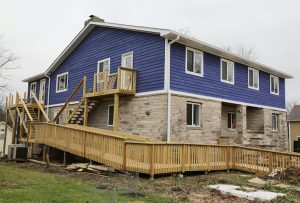
The pandemic allowed BCL residents to invest more time and energy in the organization. Zackary Dunivin, for example, was able to secure funding for the co-op’s fourth house, The Trellis, at 921 W. 9th St. | Photo by Laura Lasuertmer
Which House found itself in the middle of the strict-to-lax spectrum, writing an initial policy that did not change with people’s changing behavior. Zackary says, “Over time, people’s understanding of what was acceptable behavior became way broader.… There were conversations around it but we rarely had policy changes to reflect it. Which is really kind of in step with the way we do things. We are just not very litigious. We don’t really write things down. Practice is the rule rather than the policy.”
For those residents of Goodlawn who sheltered in place exclusively with one another, they were grateful to have each other but also grew weary of being together. This was true also at Which House. Zackary explains that while most residents lived together well, one person’s enduring emotional distress made house meetings unbearable. This particular relationship did not weather the strain of group isolation. Even during normal times, living well with others is the greatest gift and challenge of intentional community. Parker Palmer suggests that this is because “relationships in community are so close and so intense that it is easy for us to project on another person that which we cannot abide in ourselves. As long as I am there, the person I least want to live with will be there as well.”
The silver lining to the pandemic for the co-op was the gift of time. In the absence of activities outside the co-op, the residents invested more time and energy in the organization itself. As board president, Zackary spent countless hours helping the co-op secure funding to buy the co-op’s fourth house, at 921 W. 9th St., now called The Trellis. Jasper says, “There are a lot of people who are committed and invested in the strength and growth of this organization. And we are doing improvements and making the houses look really nice, and all of the things that make a community really joyful. All of that did continue throughout this entire time.”
Zackary, Jasper, and Carsten agree that living in community during the shutdown period of the pandemic strengthened their enthusiasm for communal life. Jasper says, “Living through a crisis in community sort of confirmed my decision whether to prioritize being in community over every other aspect of my life, not specifically this community, but to be in a community with this degree of mutuality because nobody actually got through this pandemic alone.”
‘All we’ve really got is one another’
There are some basic human needs that were limited during the shutdown days of the pandemic: the need to be in the same room as other people, the need to share meals with one another, the need to hug friends. The pandemic underscored how much we need embodied, human connection. But it also reminded us of our connection to the natural world. It sent us out into our gardens, onto hiking trails, into parks, beside streams, and strolling through meadows.
At Common Home Farm, we continued to have in-person connections with the people in our community, and with large gardens and acres of trees we were able to invite friends to work and pray outside with us. It was during the pandemic that David Lasuertmer and David Watters built our prayer circles in the woods. In the absence of in-person church, we began to create our own liturgies and celebrations within the cathedral of the trees. Without as many outside connections, we were able to foster connections and rituals within the community.
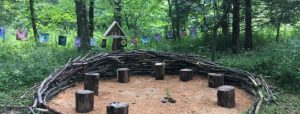
Prayer circle at Common Home Farm | Courtesy photo
With our roots in the Catholic Worker movement, we also continued to share our space with people experiencing homelessness. We have a tiny house that has been home to three different guests over the last three years. During the beginning of the pandemic, we offered hospitality to a person who was homeless and whose child was in foster care. She needed a safe place to live and have visits with her son. She sheltered in place with us, created garden beds with us, fed the chickens and harvested crops with us. Though she has moved into her own apartment now, she and her son continue to come to the farm to have dinner, to help in the gardens, and to celebrate the changing seasons.
Since the shutdown ended and life, in fits and starts, approaches “normal,” we still find ourselves being tossed around by the constant waves of uncertainty. Do we mask up for community prayer even though we are all vaccinated? With COVID cases expected to rise again this fall, do we make sure our communal meals take place outside? Or do we mostly return to our pre-pandemic ways and accept the risk that comes with that?
As Andrea said, which aspects of health do we prioritize? Mental health? Physical health? And how do our actions affect the spread of COVID in the wider community? We too are tired of these questions, but we are grateful to be wading through the uncertainty with others to whom we are closely tied. Sometimes the comfort of solidarity is all the comfort we can count on. These experiments in living closely with others — whether in a pandemic or in ordinary times — remind us that all we’ve really got is one another. We were already, always, in this together.
READ MORE: “Intentional Communities Must ‘Bend with the Times’,” by John Mikulenka, about local intentional communities May Creek Farm and Needmore.
More about these intentional communities
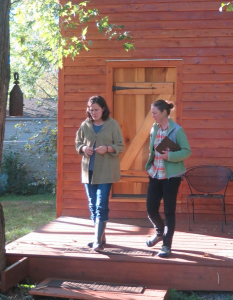
The author (right) with Andrea Martinie Eiler at The Bloomington Catholic Worker. | Limestone Post
The Bloomington Catholic Worker, founded in 2008, is a community of two families and one single adult who offer housing and hospitality to people experiencing homelessness. They live in four homes on Blair Avenue. They host a community potluck outside (in decent weather) on Thursdays at 6 p.m. For more information, visit their website or call (812) 339-4456.
Bloomington Cohousing is an intentional community made up of individually owned homes built on communal land. There are communal buildings and outdoor gathering places. Seven households currently live in the community. Two more houses have been purchased. Four additional houses are currently being built, and two of them are reserved. When all the houses are built, there will be 26 homes. Visit the Bloomington Cohousing’s Facebook page for more information.
Anne Kreilkamp founded the Green Acres Permaculture Village in 2009. It is an intentional community of three houses on the east side of Bloomington. The community focuses on cultivating deep community with each other and with the land, animals, and plants that they tend. There are currently eight adult members. They host a weekly potluck on Thursday evenings at 7 p.m. For more information, visit the Green Acres Facebook page.
Bloomington Cooperative Living creates and maintains communal housing that is democratically controlled by the residents. It owns two houses (Middle Earth and The Trellis) and rents two houses (Goodlawn and Which House) for a total of 63 bedrooms for rent. For more information, visit their website.
Common Home Farm is an Interfaith Catholic Worker community on Persimmon Ridge, ten miles north of Bloomington. The 10-acre farm comprises three families, two of which live on the property, but guests and volunteer workers are welcome. Visit their website for more information.

